|
On October 15, 2004, my
sister JoAnn Byron and I arrived in Warsaw, where we were met by Artur Wiatr,
who is a guide at the Biebrzanski National Park, very close to the area we
wanted to visit. A very earnest and good man, and a good guide, Artur was a
pleasure to be with, and always made us feel comfortable. We had many good
conversations on a range of subjects. We were glad that Jose Gutstein had
recommended him to us. Our desire was to visit known ancestral towns of ours -
Szczuczyn, Radzilow, Wasosz, Grajewo, Konopki-Blonie, Karwowo, Bogusze, Nieckowo,
Piatnica and Kaminski. We saw all these Lomza gubernia towns and more.
Treblinka is on the way
from Warsaw to Lomza, so we stopped and visited it. It was a cold, clear, windy
autumn day, and so quiet you could hear a leaf fall. It was a very moving
experience. The symbolism created by the railroad ties, the pit, the main
memorial, and most of all, the stones, so many, many of them is chilling. It is
not something that can be forgotten once it is visited. It was not until much
later, during further family research, that I learned that this place was the
final resting place for a number of our relatives.
We stayed at the Hotel
Baranowski in Piatnica, which we were very happy with and would definitely
recommend to others. Piatnica is just north of Lomza. There are some lovely
views looking towards Piatnica from Lomza, across and overlooking the Narew
River.
|
|
|
|
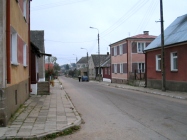 |
|
Radzilow: Looking south,
down Piekna Street |
|
|
| |
|
Our first whole day was
spent mainly in Radzilow, the home of our great-grandfather, Mejer Hersz
Kowalski. It was a little hillier than I had foreseen, but this shouldn't have
been surprising, given the streams nearby. The streets were not empty, but
neither were they teeming with people. The town seemed to have its reserve.
Artur had arranged for us to meet several local townspeople, but one of them, an
elderly man, had just been hospitalized and so was not available. The lady who
met with us was very cordial and helpful, and took us for a walking tour around
the town. It was an overcast day, and as we walked and reflected on what was and
what is, that seemed fitting. One looks south, down Piekna Street and cannot
help but recall that it was the route forcibly taken by so many on their way to
their fate.
On a somewhat brighter note, our host showed us the house where the
Rabbi (presumably Rabbi Zelik Gelgor, and perhaps his predecessor, Rabbi Kiwa
Goldberg) had lived, on one of the corners of the town square. We were very
moved when shown the ruins of the Kowalski blacksmith shop on Nadstawna Street,
and a nearby place right by the Matlak Creek on the west side of town where a
butcher's shop once existed; perhaps, I imagined, where one of our ancestors,
Izrael Mejerowicz Piechota once worked. We saw on the town square a building
that was pointed out to us by our host as the former fabric store of Pesza
Gutsztejn nee Zimnowicz, Jose's great-grandmother, right next to the Post
Office. After paying our respects at the memorial by the site of the barn
burning, we went on to the nearby villages of Karwowo and Konopki-Blonie, where
we knew that ancestors had once lived about 175 years ago. These were rather
picturesque little settlements. One of the brick homes in Konopki-Blonie had a
huge white stork nest on its chimney (not something one sees in Chicago, where
we are from).
|
|
|
|
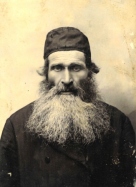 |
|
Ruben M. Palenbaum,
1890s to early 1900's |
|
|
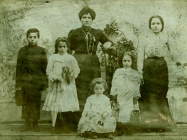 |
|
Kowalski/Mejranowski Family
Zlata Perla (nee Palenbaum) (widow of
Mejer Gerszk Kowalski, from Radzilow) Mejranowski and her
five children, 1904 |
|
|
|
|
|
With the time we had
left that day, we drove briefly through Szczuczyn for a quick look, and then
stopped off in nearby Nieckowo, where our great-grandmother Zlata Perla
Palenbaum had lived with her second husband, Abram Mejer Mejranowski. Artur
found an older man who had known a few of the local Jews, and we drove back into
Szczuczyn with him, where he pointed out the two old Farberowicz mills, one in
ruin and one still functional. He also pointed out that the current USC (Civil
Registry) office was not the one used previously, and showed us where that older
one (now a police station) was. This was of great interest to us, as one of our distant uncles, Rubin Abramowicz Palenbaum had signed as a witness in the old USC
office on hundreds and hundreds of birth, marriage and death records,
and our great-great grandfather Rubin Mortkowicz Palenbaum acted as witness for many a
death record, possibly in that building. We drove back south, through Wasosz, where a number of the
Mejranowski family members had lived. It is a smaller town than Szczuczyn,
closer in size to Radzilow. There was a pretty mill, an odd pink-colored
community building and a rather imposing-looking church here, as well as some
lovely old wooden homes (also true of Radzilow).
Artur drove us by the
western edge of Biebrzanski National Park. Nearby was the little village of Brzostowo, which we also briefly stopped at. It was right on the water's edge,
and we saw a building with a remarkable thatched roof there. One of our distant
in-laws was from this picturesque little town.
|
|
|
|
|
|
|
|
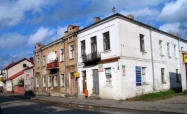 |
|
Szczuczyn: Kilinskiego Street
[Top]: West Side
[Bottom]: East Side |
|
| |
|
Another sullen,
windswept day awaited us, but again, it seemed to fit with the pensive nature of
our visit. On the way to Szczuczyn, we stopped in Jedwabne. The big church at
the town square was quite impressive to look at. The memorial at the edge of
Jedwabne and the adjacent remains of the Jewish cemetery are bleak, but very
evocative reminders of past history. Standing out in the open, at that memorial,
one can see a long ways off, and one can hear the church bells from the town
square. To do this, and to read the particular El Moleh Rachamim prayer carved
onto the memorial stone, it is not possible to maintain one's composure... We
drove on to Szczuczyn, first taking a short side visit to the tiny village of
Kaminski. The muddy, reddish-brown dirt road in this little farming village
helped us visualize what it might have been like almost 190 years ago, when our
ancestor Rubin Herszkowicz lived there.
|
|
|
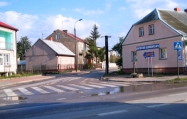 |
|
Szczuczyn: Where Krzywa
and Kilinskiego Streets meet |
|
|
| |
|
We spent a few hours
walking around Szczuczyn. Some of the neighborhood areas are very old, and
others much newer. The area of the former World War II ghetto on Krzywa Street
must have been quite small, as the street only runs a short distance. It was a
bit of a disappointment walking north down the currently named Kilinskiego
Street. There were very few older homes here, in the area where our gr-gr-gr-gr
grandfather Abram Herszkowicz (Palenbaum) had once lived, when the street was
called Nowy Miescie (New Town). In these towns, fires were not uncommon, and a
number of the wooden structures burned down long ago. One can look at the old
Post Office, which stands near where the large synagogue had been, but one
cannot get any kind of sense of what had been here, because this Post Office and
the immediate environment have been worked over and "modernized" considerably.
It is understandable, but from our perspective, disappointing.
Artur took us to
Grajewo, where a local friend of his, Janusz, gave us a walking tour of the old
Jewish area. Grajewo is larger than Szczuczyn now, but that wasn't always the
case. The railroad line made the difference, bypassing Szczuczyn. Among the
things I will most remember are an overall view of what had been a marshland
that is now a park area in the middle of town. From this view, looking down into
the park and across it, one can see a tall church steeple, a big old synagogue
building (now a movie theater), and some other buildings that up close proved to
be from the part of town that became the ghetto during World War II. We also saw
what had once been a Jewish bath-house. Janusz and Artur took us to the village
of Bogusze, where there had once been a transit camp/concentration camp where at
least one of our relatives, Szejna Bejla Kuberska had perished. We also knew,
from an 1819 marriage record, that our gr-gr-gr-grandmother Syma Joszkowna had
been from this little town. Janusz showed us that Bogusze had literally been
right on the Prussian border at one time, immediately adjacent to the then
Prussian town of Prostki.
|
|
|
|
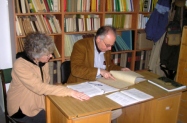
|
|
Jeff and JoAnn poring
over registers at the
Lomza Archives |
|
| |
|
I spent much of the
next day in the Lomza Branch of the Polish State Archives. It was a very
exciting experience to be able to pore over old birth, marriage and death
registers. Although I was disappointed in not being able to locate any records
pertaining to my grandmother Sora Rifka Kowalska or her father, Mejer Hersz, I
was able to find a number of family-related records. The small staff there was
helpful and efficient. My sister was able to utilize this time to visit the
remains of a local Jewish cemetery in Lomza. Late in the afternoon, Artur drove
us to Tykocin. Although this was not an ancestral town of ours, the chance to
see the synagogue there made the trip worthwhile. Unfortunately, it was closed
that day, but we were able to admire it from the outside, and we also saw the
old Jewish area of Tykocin known as Kaczorowo. This town seemed markedly
different in appearance from Szczuczyn, Radzilow and Wasosz. It's closer to
Bialystok than the others, but I don't know if that would explain differences in
layout and appearance.
We took this trip to
see where some of our ancestors had lived. It had been an experience just
learning, over the course of several years exactly where those ancestors had
lived. The help of Jose, and cousin Saul Marks added greatly to the research we
had undertaken. After spending so much time looking at paper records of birth,
marriage and death, it was good to be able to actually see these places. This,
despite and because of all that has happened. |